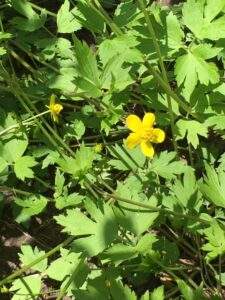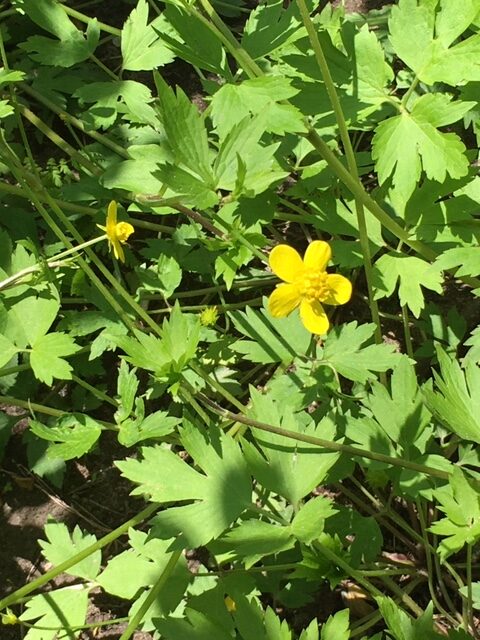May 10th
The 130th Day of the Year
But winter lingering chills the lap of May.
Oliver Goldsmith
Sunrise/set: 5:25/7:38
Day’s Length: 14 hours 13 minutes
Average High/Low: 70/49
Average Temperature: 59
Record High: 94 – 1896
Record Low: 29 – 1966
Weather
Today’s weather is almost always mild to warm, with just a 30 percent chance of rain. Highs in the 80s come 20 percent of the time, 70s come 45 percent, 60s come 35 percent. This is the first day since April 30th that chances of highs below 50 degrees are practically nil. The sun shines 85 percent of all the May 10ths in my weather history. Chances of frost: a light freeze comes once in a decade on this date, but after today, chances on a daily basis fall below five percent through the first week of June, after which they completely disappear.
Natural Calendar
This is Sweet Cicely and May Apple Blooming Season in the woods. Mayfly Season begins along the rivers and creeks. Weevil Season comes in throughout the local alfalfa fields. As Petalfall Season closes for crab apples, cherry trees and redbuds, Thrush Season, Catbird Season and Scarlet Tanager Season come to the bushes. It’s Bullfrog Season in the swamp and Spitbug Season in the parsnips.
Daybook
1982: As the hydrangeas bloom, crab apple petal fall coming to an end. May apple and fire pink blossoming. Sweet Cicely has started its three-week cycle.
1984: This cooler year, a few bluebells and one toothwort found. Sweet rockets and fleabane budding.
1985: At the pond, hemlock was heading up. Plantain was blooming at Wilberforce. Canadian thistle was up to my chest, budding. Last garlic mustard fading, like in Arlington Virginia on April 26, but still chest high, dominating the undergrowth. Sweet rockets full, columbine full. Canopy complete here. Daddy longlegs on the hobblebush. Yellow swallowtails mating, almost tame. First forget-me-nots and corn salad. Wild phlox fading.
1987: Cascades: Ducklings seen big and fat, at least two weeks old. Last of the trillium. May apple blooming. Robin’s fleabane full bloom. Yellow stargrass full. Water cress, ragwort, garlic mustard still dominate the woods. Spring cress and betony done. Golden Alexander along the paths. First maple-leaf waterleaf in bloom. Shooting star fading, columbine late full. Blue cohosh still holding (gone by the 12th). Some poppies full bloom in the village. First black raspberries flower. The village maple canopy is complete. It’s summer in town before it is in the woods, seasons depending as much on species as on the weather. First yellow swallowtail seen (one seen on March 24 in Mississippi, 1989). Patches of iris in full bloom.
1988: Redbuds faded suddenly today, their leaves replaced flowers almost overnight. Daisies bloomed by the south wall.
1989: Buckeyes full. Garlic mustard just starting. Waterleaf budding. Jack-in-the-pulpit still strong. Wild lettuce has huge basal foliage. Sweet rockets budding. Virginia creeper has been leafing this past week. A third of the high canopy is in. Only a few spring beauties left. Squirrels eating the new green mulberries. Rose of Sharon leafing. Viburnum full leaf and bloom. Purple deadnettle yellowing. Sedum early full in the yard. Pink honeysuckle full bloom in the village, mine still budding.
1991: At South Glen, orchard grass and delicate brome are at their sweetest, late garlic mustard flowers at their tips now, sweet rocket strong. Ginger hidden but full bloom, full waterleaf. Touch-me-nots huge, pacing wood nettle to my thighs. Phlox being overgrown. Silver olive trees full bloom. Last of the yard’s tulips coming undone. Dogwoods hold. Osage leafing, maybe a fourth size, sycamores a little ahead. First spitbugs seen in the yard. Wild cherry and locust in bloom. Canopy closing quickly. Center of hydrangea season.
1993: Air sweet with pollen (the most pollen in 20 years, reported on the news). First rockets opened today, one seen at the turnoff to Grinnell, one in the south garden. Early patch of purple iris along Xenia Avenue. At Wilberforce, gum trees are dropping their flowers, leaves half size. Maple seeds falling. In the river valley, the canopy is flushed, quickly maturing, still luminescent, fresh, adolescent, scanty. Bright blue egg shell on the sidewalk at the sunken garden. Junipers have new two-inch growth. One honeysuckle full bloom at Jim Oldham’s. Some redbuds are leafing, their flowers deepening, then becoming overwhelmed by foliage. Aphids found on two budding rose plants tonight.
1994: Now the dark purple dwarf iris have started in front of the house, and taller varieties first opening along Dayton Street. Some late yellow and red tulips are still in full bloom. Ranunculus, golden ragwort, water cress, garlic mustard, violet wild geranium, winter cress, spring cress, light purple phlox at their best, peonies with large buds, first pyrethrum unraveling at the same time the first columbine is opening. It’s early fleabane, sweet rocket, and sweet Cicely time, last days of miterwort, redbud and dogwood. Bleeding hearts are getting old. Honeysuckle bushes are starting, oaks in bloom. Last solar eclipse of the century today. It was dark outside at noon even though the sky was clear and the sun was shining. The whole yard seemed to be in the shade.
1999: Now mock orange, daisies, pyrethrum in the garden push out simultaneously. Six leaves on the water lily. Tadpoles getting medium sized. Catalpa leaves a third developed, pacing the black walnuts. Thyme and horseradish both full bloom in the garden.
2000: Sixteen leaves on the pond’s water lily. Tadpoles large and now have spots. Red admiral butterfly seen along the north path today. Yesterday, a small, orange fold wing butterfly.
2001: Peonies are out in Xenia. Blue flag iris and comfrey suddenly blossom along the north border. First reddening strawberry found. Wild black raspberry full bloom. The puppy, Bella, found another snake skin today, this one under the peony bushes. Goslings big and fat on all the ponds.
2002: Angelica waist high, nettles knee high. Orchard grass perfect for pulling and chewing. First mock orange flowers.
2005: Hawthorns bloomed today at the triangle park, but even the bushy crab apples, late to flower, are losing their petals in the 80-degree days. Black walnut trees are producing small leaf clusters, and the high locusts are emerging. Mountain maples are coming in at the Antioch School. Iris are budding here, blooming around town. Honeysuckle buds are ready to blossom any minute.
2006: Hawthorns at the peak of their bloom in the park, Korean lilacs in the yard. The first blue flag and the first iris flowered in the north garden this morning. The last bluebell blossom faded by the shed, lungwort long finished. Pink spirea has small bud clusters in the south garden. Mateo’s weigela started opening today.
2007: The second yellow swallowtail of the year seen this morning. Coleus planted under the apple tree. The hawthorn at the triangle park was in early bloom. More iris and all the poppies in town blooming. The tree line was completely pale green on the way to Octa this afternoon. Many corn fields had sprouted, sprouts about three inches tall. Winter wheat here was strong, maybe eight to twelve inches high. Fat, fuzzy goslings seen at Dewine’s pond.
2008: The first sweet rocket in town seen at Don’s this morning. Bridal wreath spirea in full bloom at Katie’s. Ranunculus in early bloom by the house. Red double peonies noticed along Elm Street.
2009: Locusts are blooming in Wilmington, and fleabane.
2010: Jeanie reported a baby sparrow begging.
2012: To Dayton: Many catalpa trees seen in full bloom, more yellow poplars blooming, and early nodding thistles open.
2013: A brown toad with a light stripe down his back (like in a photo I saw of a Western Toad) was sitting on the front step when I came home from walking Bella this morning. Now that the front red crab apple and the pink quince in back are completely done blooming; the bright pink azalea holds the dooryard space together. Rick brought over a milkweed plant, six inches tall.
2014: In the yard: The red crab apple and the pink quince have dropped all their petals. Indian hyacinth and tall allium and star of Bethlehem in full bloom, last bluebells, first spiderwort, early ranunculus, peonies an inch across. Hackberry finally leafing, Jeanie’s river birch filling in slowly, pale April green. The trumpet vine is putting out a few leaves, and the forsythia is budding. The redbuds that did not flower have tiny red leaves. At Ellis Pond: one sweet Cicely open, silver olive shrubs in bloom, toads calling, wild cherry budded, yellow buckeye and red horse chestnut in full flower, mountain ash full white flower clusters, Halesia Jersey Belle white with bell-like flowers, ginkgo leaves two inches, sycamore leaves one to two, scarlet oak three inches. In town, snowball viburnums open everywhere. Only scattered geese nesting in the fields, the great flocks of fall, winter and early spring broken and scattered for mating and raising their young. Some cornfields show their sprouts.
2015: All the honeysuckles are blooming all at once. It seems they came in overnight. As I jogged down Phillips Street at about 5:45, I approached a pileated woodpecker that was working at the rotten wood of a tree stump. He let me get within just a few feet before he flew off. Through the village: azaleas and Korean lilacs and bridal wreath all around.
2016: Scattered inventory: the village flowering just like last year, with poppies and sweet rockets and many iris as well; in the yard, the first blue spiderwort and the first white and blue spiderwort have opened; honeysuckles, lamium, celandine, ranunculus, wild geraniums and allium are full; Indian hyacinths and wind flowers done; wood hyacinths starting to brown close to the ground; peonies straining to open – a few buds showing petal color; north side viburnum still bright white; the azalea, garlic mustard and star of Bethlehem late; waterleaf foliage very tall; some bamboo to twelve feet; rhubarb almost ready to pick for pie; the decorative grasses struggling through the weeds; trumpet creeper vines with feathery foliage; wisteria with numerous flower clusters, but still quite bare; hosta and ferns full size; Joe Pye weed to eighteen inches; red amaranth sprouted under the weeds perhaps a week ago, needs to be thinned; last tulips, the white ones, ready to collapse; in the dooryard garden, the yellow bell flowers are still open (came in maybe a week ago). In the fields, winter wheat is more than a foot tall, and the corn has sprouted.
2017: The first long-bodied orb weaver wove its web across the west end of the pond overnight. I saw the first silver-spotted skipper in the circle garden late in the morning.
2018: The ancient azalea in the dooryard garden is putting out a few blossoms. Above it, the red crab apple blooms are fading. The south border hackberry is leafing. In the north side of the village: first iris, deep purple and first daisies. Dogwoods are in full flower in town, Jill’s pink one delicate and almost draping against the front porch. Cressleaf groundsel colors the fields gold. Bridal wreath hangs across the dooryards. Pale rose-like petals of the quince float down to the surface of the pond.
2019: Heavy rains turn the local Miami River waterfall, the “cascades” into a thundering torrent.
2020: Lilac Winter continues with raw winds and storms.
To be creative, man must relate to nature with his senses as much as with his common sense, with his heart as much as with knowledge. He must read the book of external nature and the book of his own nature, to discern the common patterns and harmonies.
Rene Dubos


